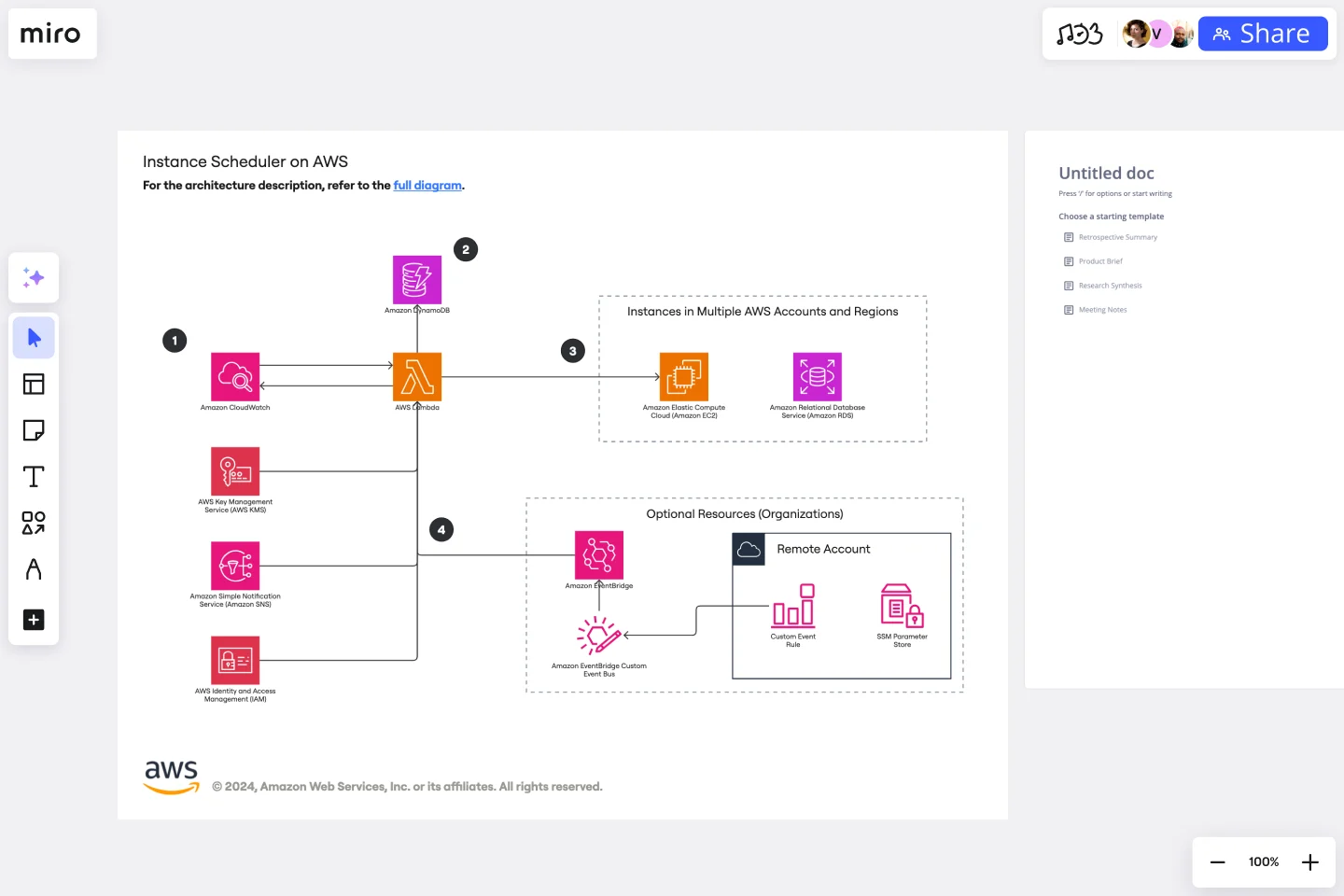Instance Scheduler on AWS Template
Automate the scheduling of Amazon EC2 and Amazon RDS instances with the Instance Scheduler on AWS Template, ensuring these resources are operational only when necessary. This will lead to more efficient and cost-effective management of AWS resources.
Available on Enterprise, Business, Education plans.
About the Instance Scheduler on AWS Template
The Instance Scheduler on AWS template is a reference architecture from the AWS Solutions Library. It provides a framework for automating the start and stop schedules of Amazon EC2 and Amazon RDS instances. The primary goal of this template is to help users save on costs by running instances only when needed. Organizations can use this template to implement a more efficient and cost-effective cloud resource management strategy.
How to use the Instance Scheduler on AWS template
Review the template: Once you're on the board, take some time to familiarize yourself with the layout and components of the template. This template outlines the architecture for scheduling instances and includes various elements such as EC2 instances, RDS databases, and scheduling mechanisms.
Customization: Although the template comes pre-filled, it's designed to be flexible. You can customize the template according to your specific scheduling needs and preferences. This might involve adjusting the start and stop times for instances or modifying the scheduling logic.
Implementation: After customizing the template, the next step is implementing the architecture in your AWS environment. This involves setting up the necessary AWS services and configuring them as outlined in the template.
Monitoring and adjusting: With the Instance Scheduler running, monitor its performance and impact on your AWS environment. You may need to make further adjustments to the scheduling parameters to optimize costs and resource utilization.
Why use the Instance Scheduler on AWS template
The Instance Scheduler on AWS template is invaluable for organizations looking to optimize their AWS resource management. It not only simplifies the process of managing instance schedules but also ensures cost efficiency by automating the start and stop of instances based on demand. Here are the main reasons to consider using this template:
Cost savings: Automating the scheduling of instances can lead to significant reductions in cloud computing costs by ensuring that you only pay for the resources you actually need and use.
Simplified management: The template automates the otherwise manual tasks of starting and stopping instances, freeing up time and resources for other priorities.
Optimized resource utilization: By running instances only when needed, the template helps in optimizing the utilization of cloud resources, ensuring that you get the most out of your AWS environment.
This approach to managing AWS instances not only contributes to a more efficient cloud resource management strategy but also aligns with the goals of sustainability and operational excellence.
Get started with this template right now. Available on Enterprise, Business, Education plans.
5-Set Venn Diagram
Works best for:
Venn Diagram
Analyze complex data with the 5 Set Venn Diagram template. This tool allows you to compare and contrast five different sets of data, highlighting intersections and unique elements. Perfect for in-depth data analysis, research, and strategic planning. Ideal for analysts, researchers, and educators looking to present comprehensive data insights in a clear and visual manner.
On-Premise to Cloud Migration Process Flowchart Template
Works best for:
Flowcharts
The On-Premise to Cloud Migration Process Flowchart Template is a strategic tool designed to streamline the transition from traditional on-premise systems to more flexible, scalable cloud-based solutions. This template acts as a visual roadmap, guiding teams through each phase of the migration process with clarity and precision. By breaking down the migration into manageable steps, it ensures a comprehensive approach, minimizing risks and aligning with best practices for cloud adoption.
SDLC Template
Works best for:
Diagramming
The Software Development Life Cycle (SDLC) template is a well-designed visual tool that helps software development teams follow a structured approach from the initial concept to the final deployment of the software. One of the most significant benefits of using this template is that it promotes clear, streamlined communication among team members. By breaking the development cycle into distinct phases, all stakeholders can stay informed about the progress of the project and understand their responsibilities within the larger context. This enhanced communication reduces the chances of misunderstandings and ensures that everyone works together towards the common goal of delivering high-quality software. The template acts not only as a roadmap but also as a shared language for the team, improving collaboration and the efficient progression of the project through each critical stage.
Euler Diagram Template
Works best for:
Business Management, Operations, Diagrams
Euler diagrams are valuable for showing different relationships between subjects by representing them with circles or "cells." Euler diagrams are frequently used in IT systems to show how objects relate to one another and how they interact. However, you can use them for any sort of explanation that needs to show connections.
Breadboard (UI Flow Diagram)
Works best for:
Diagramming
The Breadboard (UI Flow Diagram) template offers a visual framework for designing and prototyping user interfaces (UIs) using the breadboard method. It provides elements for arranging UI components and defining user interactions. This template enables designers and developers to create interactive UI prototypes quickly and iteratively, facilitating user testing and feedback. By promoting rapid prototyping and experimentation, the Breadboard (UI Flow Diagram) empowers teams to design intuitive and user-friendly digital experiences effectively.
Yes No Flowchart Template
Works best for:
Diagramming
The Yes-No Flowchart Template is a simple and efficient tool that helps to simplify complex decision-making processes into clear and easy-to-follow steps. This template uses standard shapes to illustrate processes, decisions, and outcomes, with arrows that guide users from one action point to the next based on binary 'yes' or 'no' decisions. Its most prominent benefit is its ability to bring clarity to decision-making. By presenting processes visually, teams can effortlessly understand and navigate complex scenarios, ensuring that each step is transparent and reducing the potential for misunderstandings or missteps.
